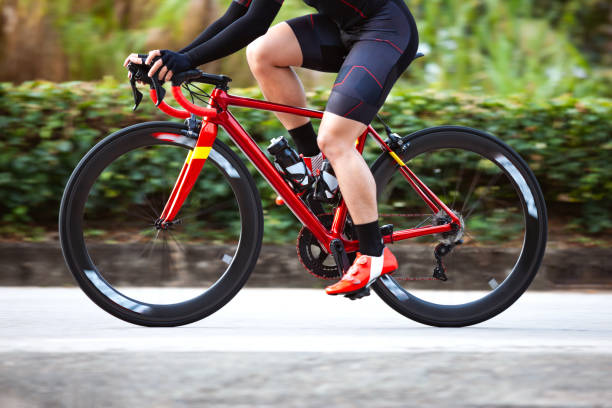Endurance Bike vs. Gravel Bike [Similarities and Differences Explained]
There are many types of bikes in the market, and some even have intersecting meanings. Thus, it’s easy to get confused about which is which. While these two types focus on giving comfort rather than performance, the two are still different. Being able to discern one from the other is necessary to pick the bike that most suits you.
Table of Contents
Similarities of Endurance and Gravel Bikes
Endurance bikes and gravel bikes are actually pretty similar. They are bikes that favor comfortability and are better for adventuring. The two bikes’ low gears and wide tires make it handy and easy to use. On top of that, the bike’s build takes posture in mind to keep even long journeys enjoyable.
Their design makes them suitable for long rides where a bit of a difference in speed can be negligible and is better off traded for more comfortability. While these two aren’t the best for competitive use, they are reliable for daily use.
The downside is that they lack speed and handling compared to other bikes. The bike’s aerodynamics are also affected, as the person using it tends to assume a less aggressive posture. Because of this, they are not recommended for competitive use since their design lacks performance.
Differences of Endurance and Gravel Bikes
Generally speaking, you’d pick endurance and gravel bikes if you’d like some comfort in your ride. The two are pretty similar in that picking one over the other doesn’t have serious consequences. Though they do have their own specialties, one would entice you more than the other. Most of their difference resides in their compatibility with certain types of terrain.
The endurance bike likes on-road use and leaves you feeling most at ease when going for long-winding rides on pavements. It has the best experience when riding due to its ability to. In this case, the endurance bike is superb at the comfort it provides.
On the other hand, gravel bikes tend to be more versatile, able to go on both pavements and off-roads such as dirt paths with less difficulty. The comfort of the gravel bike, despite changing roads, makes it desirable when you’re often met with rugged trails.
What Makes a Gravel Bike?

Gravel bikes consist of different frame materials, like aluminum, carbon, or steel. They have long wheelbases and low bottom brackets, which help with stability. For comfortability, they have a short reach high stack to keep you at an upright form while riding. The tires tend to be large, between 30mm to 50mm. This is so that the bike improves on comfort and stability. It also has low gear that could lower speeds but is better at climbing hills.
What Are Gravel Bikes Good for?
Gravel bikes are famous for being well-rounded. Their easy maneuverability makes them exceptional for off-road use. Their on-road capabilities are also somewhat decent in that they can function on any terrain. This means that you can go into rough terrain with hardly any difficulty.
It also offers decent stability and durability without sacrificing comfort. If you want a sturdy, reliable bike that is good in any situation, you can’t go wrong with a gravel bike.

Gravel Bikes: The Pros
1. Flexible
The gravel bike’s specialty is its ability to adapt to any situation. It can function pretty well on the typical road, but it excels at dirt roads and other rough paths. It can even work on the tarmac, muddy roads, and gravel. With gravel bikes, you can also opt to travel through different terrain, which will open up new and more accessible pathways.
2. Durable
Gravel bikes mainly consist of sturdy materials. The gravel bike thrives even in rough environments where other bikes would have difficulty traversing. It is designed for use in situations where environments tend to be rough and uneven. Its adaptive features make it work without getting damaged as much. A gravel bike is handy, be it rain or shine, it’s safe to say.
3. Geometry
Gravel bikes feature an upright riding position. The posture might not be the best for speed, but it does give you a more comfortable experience while on the ride. The bikes’ compliance may also help add comfort, though at the cost of performance.
Gravel Bikes: The Cons
1. Not the best at on-road travel
When used on more developed streets and pathways, gravel bikes are less effective than other bikes. With their specialty being on paths less traveled, they tend to be less effective on highways. They also tend to lose in speed at on-road travel against certain bike types, and the endurance bike still wins if you prefer smooth rides. If you are often in situations with distinguished terrain, you’d be better off using other bikes.
2. Bad performance
The downside of gravel bikes is that they’re inferior to other bikes’ performance. Its speed is subpar compared to others, meaning that it may not be the first choice for high speed and good handling. Because it favors comfortable seating, it does not have an edge in aerodynamics.
Add to that its relatively high weight, and it gets outpaced by other bike choices relatively easily. The gravel bike concedes too much on comfortability to be an excellent choice for sports. In terms of anyone’s ability, it tends to lose out to any other bikes, and if you want to use an off-road bike for races, cyclocross bikes are still better.
3. Master of None
The gravel bike is a safe choice, but if you’re looking for the best of something, it’s probably not your style. Being a jack of all trades means that it’s suitable for any situation, but not the best at any one thing. It’s unsuitable for competitive use as its design shifts more into comfortability. Nor is it the best. If you’re gonna get a bike for something specific, there is most likely a better choice than a gravel bike for the job.

What Makes an Endurance Bike?
Endurance bikes have similar geometry to that gravel bikes. They tend to have a short reach, high stack, long wheelbases, and low bottom brackets. Although the endurance bike’s wheels tend to be smaller, with a size of about 30mm. You can also replace it with bigger tires, as they tend to have greater clearance to allow for bigger tires.
What Are Endurance Bikes Good for?
Endurance bikes are some of the smoothest bikes to ride on asphalt and similar roads. The large tires tend to absorb more shock, and it is made with the idea of minimizing road vibration. This technology and comfort enable you to go for long rides without tiring. If you plan to go through long rides on paved pathways, you will get a lot of mileage with endurance bikes.
Endurance Bikes: The Pros
1. Comfortable
The geometry of the endurance bike is one designed to be comfortable to its user. Like the gravel bike, it encourages users to have an upright posture. This design is perfect for a relaxing ride as it does not affect the muscles as much and lessens fatigue. You may also want to put in mind compliance if you’d like to have a more relaxing time.
2. Great to add modifications
An endurance bike is excellent, but how about you add more to your chariot? You can add a fender to help shield you from water splashes in case of rainy days. If you need more storage, you can attach a rack that will fit nicely into your bike. You have full reign over what you add, and since you are probably not going for speed and pure performance, it may prove valuable to tinker with it.
3. Good for highway travel
The endurance bike is most sought out for its compatibility with well-paved roads. It has the unique feature of canceling out roads’ vibrations, reducing stress on the body. It functions well on long stretches of developed roads due to its ease and comfort. The bike functions well because it gives the most relaxing ride on-road out of all bike types due to its focus on comfortability.
Endurance Bikes: The Cons
1. Not suitable for off-road travel
The endurance bike’s weakness is that it is unreliable in traversing off-road. That is not to say that it is unusable, but it tends to be much less effective. It is not made to weather rougher roads that gravel bikes frequent. As such, it is not advisable to take an endurance bike if you’re going to be primarily using it.
2. Lacking in performance
The seating features do not function much with aerodynamics in mind like gravel bikes. The ride is not the most optimized in speed and is not the best choice for use in athletic sports where speed is critical. Similarly, lower wheel blades also mean that it’s not as good at making crucial turns, which are necessary for competitive backgrounds.
Due to its emphasis on smooth riding, it tends to fall off at certain aspects, like performance. Endurance bikes might not be for you if you’re looking for speed and handling.
3. Just for leisure
The endurance bike concedes many traits to better focus on its comfortability. Its weak performance and incompatibility with off-road travel offset its comfortability in most situations to the point where you need to sacrifice a lot for a pleasing ride experience. Endurance bikes might not be your first choice unless you’re using this almost exclusively for on-road travel and wouldn’t mind losing out on performance.
